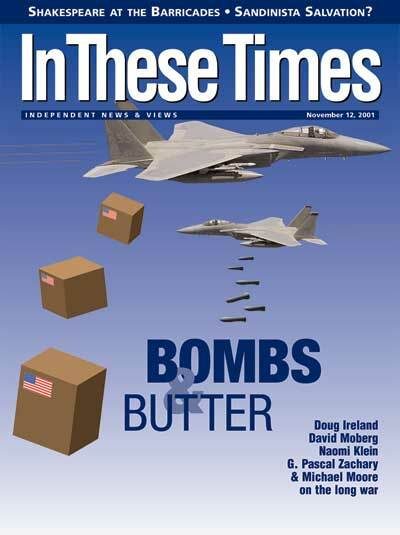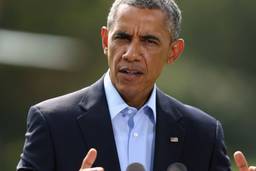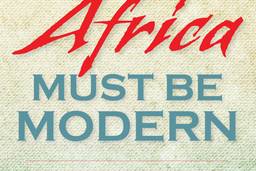The images on the first few days of air attacks by the United States on Afghanistans
Taliban regime were a strange juxtaposition of bombingand food drops.
Guns and planes are playing a decisive role, but there is another weapon in
this war on terrorism: humanitarian aid. And while desperately needy refugees
hopefully benefit from the assistance, they are also being used as pawns.
Even before the United States fired a shot, President Bush pledged hundreds
of millions of dollars in aid to Afghan refugees. The administration wants to
portray itself as helping beleaguered Afghans, and relief aid could make the
United States appear merciful, especially to Islamic countries that are troubled
by the bombing and the inevitable civilian casualties (such as the four U.N.
security workers killed on October 9). And Americas linkage of food and
guns may helpespecially when the CIA comes to recruit agents out of the
Afghan refugee camps in Pakistan.
But the American PR offensive seems brittle. Doctors Without Borders is already
calling U.S. humanitarian aid counter-productive so long as its tied to
air attacks. Such action does not answer the needs of the Afghan people
and is likely to undermine attempts to deliver substantial aid to the most vulnerable,
says Dr. Jean-Hervé Bradol of Doctors Without Borders, which estimates
that 1 million Afghans are on the move, seeking refuge. The U.S. food drops
are believed to satisfy the needs of only 37,500 people a day. Millions of Afghans
are in danger of starving.
But the United States is not alone in exploiting the humanitarian crisis. The
Taliban still seems to think that if it can raise the costs of a fight, then
the U.S. coalition will fracture. The Afghan leaders wish to portray themselves
as innocent victims of U.S. aggression, and even though they have brought on
many of their own misfortunes, their cause might be helped if U.S. bombs kill
too many civilians or destroy vital infrastructure that brings on further starvation
or disease.
Although the Taliban chieftains may decide they are safer hiding in the caves
of Afghanistan, they could easily send loyalists into international refugee
camps run by the United Nations. Using the relative safety of these campsand
their resourcesthey could help sustain the Taliban resistance in Afghanistan.
The Taliban also may be encouraging, if not assisting, ordinary Afghans to flood
into neighboring Pakistan to destabilize this wavering U.S. ally.
Yet Pakistan is already using the specter of hundreds of thousands of Afghan
refugees as leverage against both the United States and Afghanistan. Pakistan
surely will exact a price from the Americans for receiving Afghan refugees.
The price, beyond what the United States already has paid in lifting
sanctions on Pakistan for its testing of nuclear weapons, could prove to be
billions of dollars in American aid to the military government. That government
may also use Afghan refugees against the Taliban, citing their presence as a
pretext for helping topple the regime or as a reason to endorse a U.S. land invasion.
Of course, the use of humanitarian aid as a weapon of war is not new. In Rwanda,
after the Hutus systematically killed a half a million Tutsis in 1994, Hutu
leaders fled to neighboring Zaire (now Congo) and used the safety and resources
of U.N. refugee camps to mount further attacks on Tutsi forces. The West ended
up protecting killers in the rush to house, feed and clothe refugees.
In 1999, Slobodan Milosevic drove out Muslim Kosovars from southern Serbia
partly as a way of raising the costs to the NATO alliance fighting against him.
By creating a vast pool of Kosovar refugees, Milosevic hoped to destabilize
neighboring Macedonia, where dominant Slavs were already in a tense standoff
with minority ethnic Albanians. While Milosevic now awaits trial for war crimes
in The Hague, he has left a legacy of strife in Macedonia. Earlier this year,
Kosovar refugees (along with Macedonian Albanians) mounted an armed insurrection,
launching attacks from the safety of positions inside U.N.-controlled Kosovo.
As Kosovo and Rwanda show, so-called humanitarian crises often confuse the
international community and raise troubling moral questionsquestions that
should be asked about the current crisis in Afghanistan. Helping Afghan refugees,
aid donorsand their agents on the groundmay be helping the Taliban
regime either to regroup or stave off annihilation. All this raises doubts about
the wisdom of the Bush administration in linking bombs and humanitarian aid
so closely. As Doctors Without Borders argues, such a link puts a cloud over
independent aid organizations who are less likely to be perceived as impartial
actors in the future.
Ultimately, the militarization of humanitarian aid may do precisely what the U.S. public doesnt want: prolong the suffering of refugees, undermine real aid and render the bombing campaign a failure.

I hope you found this article important. Before you leave, I want to ask you to consider supporting our work with a donation. In These Times needs readers like you to help sustain our mission. We don’t depend on—or want—corporate advertising or deep-pocketed billionaires to fund our journalism. We’re supported by you, the reader, so we can focus on covering the issues that matter most to the progressive movement without fear or compromise.
Our work isn’t hidden behind a paywall because of people like you who support our journalism. We want to keep it that way. If you value the work we do and the movements we cover, please consider donating to In These Times.








